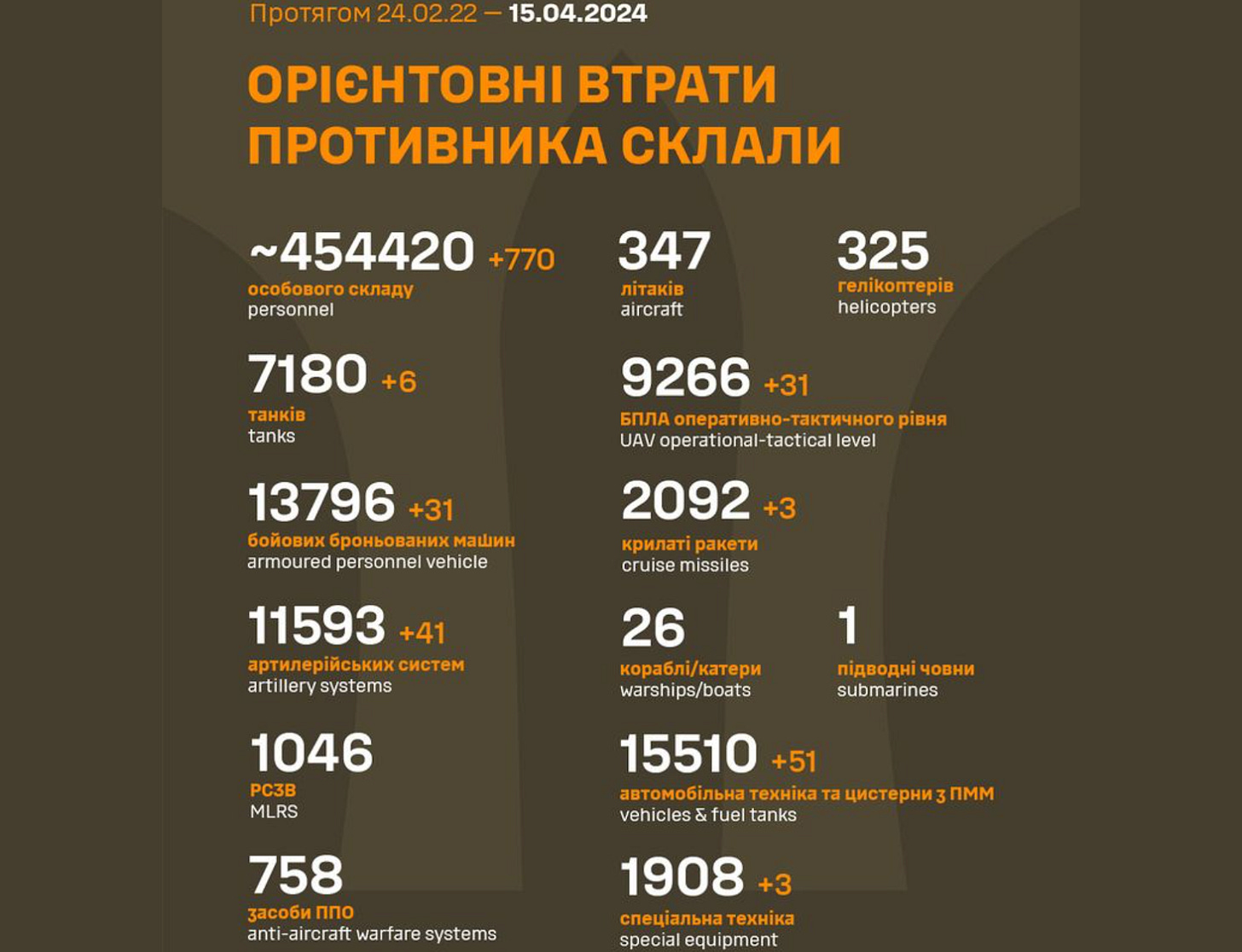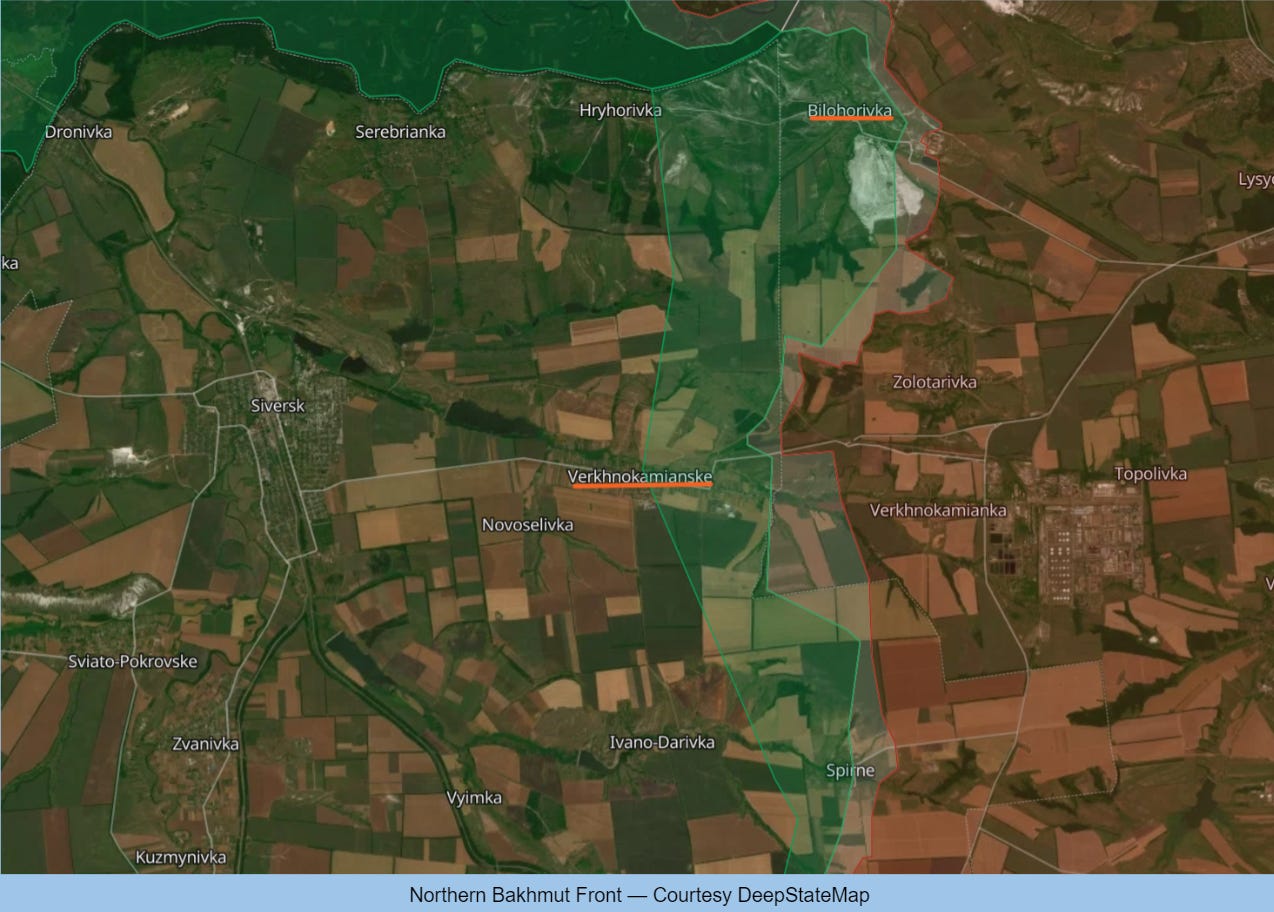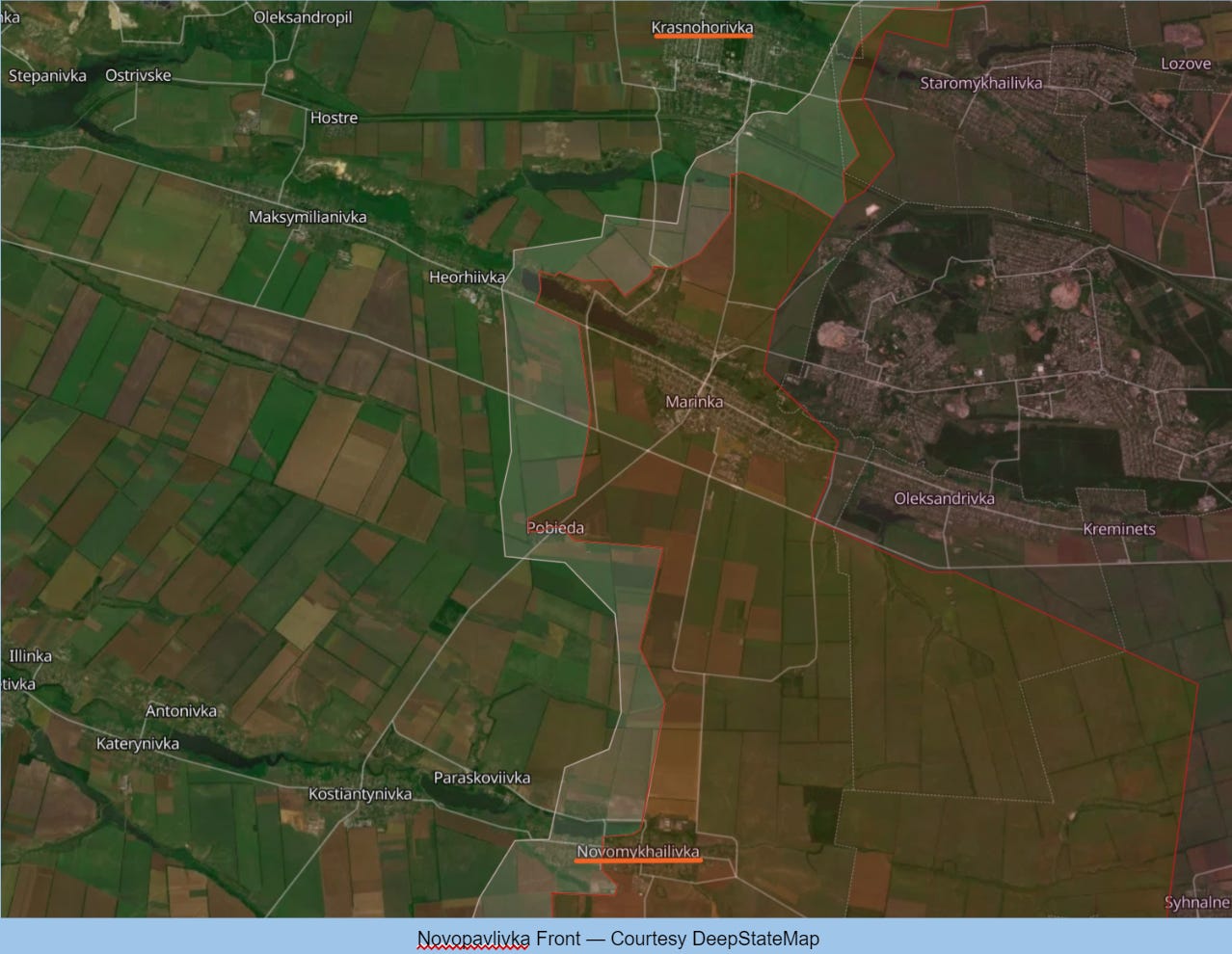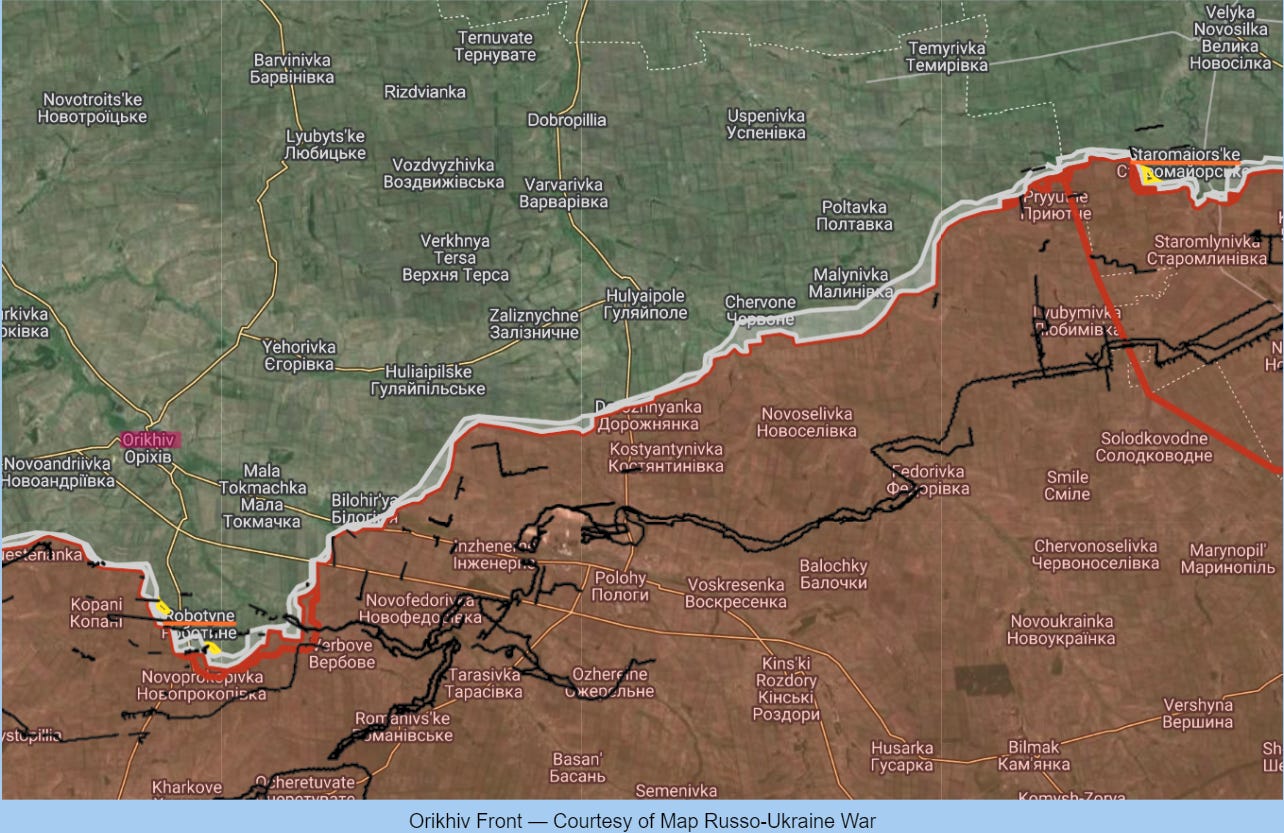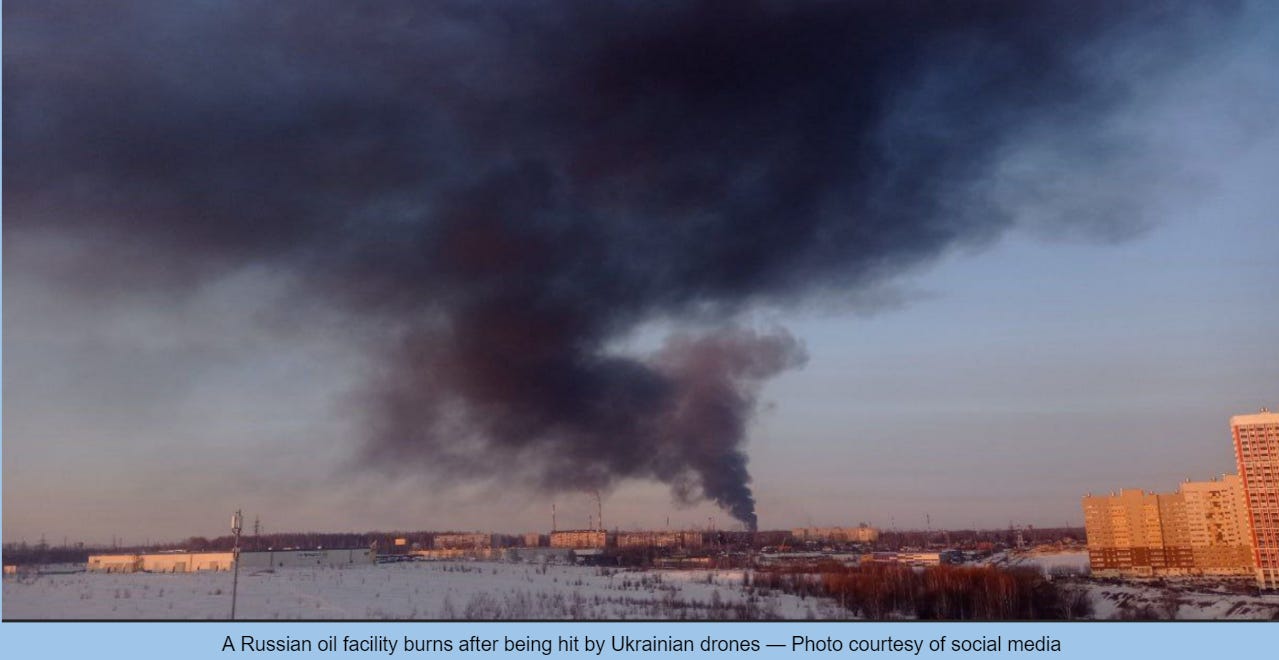Slava Ukraini! In early 2022 I began a Telegram channel aggregating news from a number of sources daily on the war in Ukraine. Since June 2023 I have provided a daily draft for the Ukraine War Brief Podcast collecting news from over 60 sources daily, much of which forms the basis of the script. While the Podcast is on hiatus I will make this Draft available here both on my own Substack and The People’s Media for those who wish to keep up with events on a daily basis.
INSIDE UKRAINE
ALONG THE CONTACT LINE
GSAFU Morning Report
The General Staff of the Armed Forces of Ukraine in its situation update at 06:00 on Apr.15 stated that it was day 782 of the full-scale invasion of the Russian Federation against Ukraine.
During the past day, 54 combat engagements took place. Over the past 24 hours, the enemy carried out 8 missile strikes, 85 air strikes, and 98 MLRS attacks across the positions of our troops and settlements. As a result of the Russian attacks, unfortunately, there are dead and wounded among the civilian population. Destruction and damage to residential buildings and other civilian infrastructure.
At the same time, Ukrainian soldiers continue to inflict losses in manpower and equipment on the occupying troops, exhausting the enemy along the entire front line.
Ukrainian missile forces struck 5 control points and 1 warehouse of enemy ammunition.
Air Force Daily Report
The Ukrainian Air Force in its situation update at 06:00 stated that during the previous day they launched air strikes on 22 areas of concentration of enemy personnel, weapons and military equipment.
The Khortytsia operational-strategic group
(Responsible for the Kup’yans’k, Lyman, and Bakhmut axes, in the northeastern part of Ukraine. )
Kup’yans’k axis: The enemy did not conduct any offensive (assault) operations in this area. Ukrainian Defense Forces continue to hold their positions.
Lyman axis: The enemy did not conduct any offensive (assault) operations in this area. Ukrainian Defense Forces continue to hold their positions.
Bakhmut axis: Ukrainian forces repelled 10 Russian attacks, supported by aviation, in the vicinities of Bilohorivka (Luhansk oblast) Verkhn’okam’yans’ke, Novyi, Chasiv Yar, Klishchiivka and New York (Donetsk oblast).
Map of the Northern Bakhmut sector below
Defense Minister: Russians concentrate forces for breakthrough west of Bakhmut
Russians are concentrating forces for a breakthrough west of Bakhmut, Minister of Defense Rustem Umerov said on 14 April after visiting combat units on the frontline.
Many Ukrainian and Western experts assessed a serious threat of Russian troop advancements and breakthroughs on the frontline in Ukraine, primarily due to a lack of personnel in the Ukrainian Defense Forces and supplies of Western weapons.
Umerov also wrote on Facebook that he “visited combat units in the Eastern frontline direction. The situation is tense. The enemy [Russian foces] is trying to advance into the positions of the Defense Forces, concentrating on a breakthrough west of Bakhmut.” However, he said that Ukraine’s Defense Forces are effectively disrupting “these plans.”
“Despite the numerical superiority of the enemy, we are effectively disrupting these plans thanks to the defenders’ courage, training, and professionalism.”
The Tavria operational-strategic group
(Responsible for the Avdiivka, Novopavlivka, and Orikhiv axes, in the central-eastern and southeastern part of Ukraine.)
Avdiivka axis: Ukrainian defenders repelled 8 enemy attacks in the vicinities of settlements of Novokalynove, Novobakhmutivka, Umans’ke, Netailove and Pervomais’ke (Donetsk oblast) where the invaders, with air support, attempted to dislodge Ukrainian troops from their positions.
Novopavlivka axis: Ukrainian Defense Forces continue to hold back the enemy in the vicinities of Krasnohorivka, and Novomykhailivka (Donetsk oblast). The enemy made 16 attempts, assisted by air support, to breach Ukrainian defense in that area.
Orikhiv axis: The enemy conducted 9 attacks on positions of Ukrainian defenders in the vicinities of Staromaiors’ke (Donetsk oblast), Robotyne (Zaporizhzhia oblast).
The Odesa operational-strategic group
(Responsible for Kherson, Qırım, (also known as Crimea) and the Black Sea.)
Kherson axis: Ukrainian defenders continue to maintain their positions. Over the past day, the enemy carried out 4 unsuccessful assaults on the positions of the Ukrainian Defence Forces on the left bank of the Dnipro River.
TEMPORARILY OCCUPIED TERRITORIES
Nothing to report.
THE HOME FRONT
Ukraine went from energy exporter to energy importer overnight
As spring arrives in war-torn Ukraine, a familiar dread settles over the nation: the looming specter of blackouts. For the third year running, Russia has unleashed a blitzkrieg of missiles and drones against Ukraine’s power grid, aiming to plunge its defiant neighbor into darkness. Euromaidan report.
This time, the damage is severe. Despite being battered by three years of Russian strikes, Ukraine managed to export electricity to the EU, with peak values reaching 700MW.
This changed overnight on 22 March 2024, as Russia attacked objects of Ukraine’s power grid throughout the country. Ukraine’s electricity deficit reaches 2GW and Ukraine has started importing power just to keep the lights on, says energy expert Oleksandr Dombrovskyi.
Russia used their regular tactic: first, waves of drones, then cruise missiles to overwhelm Ukraine’s air defense. After this, ballistic missiles that Ukraine lacks capacity to shoot down.
This was the largest attack on Ukraine’s power grid during all its war, Ukraine’s energy minister Herman Halushchenko said. 60 drones and 90 missiles of various kinds were fired.
On 29 March, the attack was followed by 60 more drones and roughly 40 missiles. Generating capacities in central and west Ukraine were hit, including two hydropower plants.
On 11 April, Russia sent 40 more drones and 42 missiles, including six ballistic Kinzhals and five new Kh-69 cruise missiles, into the power grid objects throughout Ukraine.
The attack destroyed the largest power producer near Ukraine’s capital. It could be repaired with the help of western partners – but this task is futile if Ukraine’s air defense is not strengthened, power company Centrenergo said.
The devastation is much worse than in 2023. Russia changed its attack tactics: it used high-precision missiles to destroy power plants in regions much less protected than capital Kyiv.
Director of the Center for Energy Studies Oleksandr Kharchenko says the exact extent of damage to the power grid is unknown. He estimates that Ukraine lost 70-75% of its thermal power production and 35-40% of hydro production.
Kharchenko says that Ukraine installed gabions and drone nets on 20-25% of its high-voltage substations, which suffered the most in Russia’s last-year attacks. These worked relatively well in the latest attack, repelling multiple attacks, but there were not enough. Moreover, no physical protection will withstand a direct hit from a high-precision ballistic missile.
Two missiles heading to Odesa Oblast downed above Black Sea
The Defence Forces of Ukraine on Apr. 15, destroyed two Kh-59 guided air-to-surface missiles that headed towards Odesa Oblast over the Black Sea. The Russians attacked Odesa Oblast once again from a tactical aircraft from the Black Sea water area.
Shortly after 16:00 Monday the Ukrainian Air Force reported that two Kh-59 guided air-launched missiles were destroyed by the Defence Forces over the Black Sea.
RUSSIAN WORLD
Nothing to report.
NEWS WORLDWIDE
GOP House Intel chair says he expects Ukraine aid to pass this week
House Intelligence Chair Mike Turner (R-Ohio) was interviewed on NBC’s Meet the Press and expressed his support for Ukraine and told Kristen Welker he expects the House to pass military aid with “overwhelming support.”
When asked by the NBC News host if he anticipates a vote on the bill this week, Turner affirmed his expectation that it will pass. “Russia is starting to gain ground. Ukraine is beginning to lose its ability to defend itself. The United States must step up and provide Ukraine with the weapons it needs. And I think this week we will see overwhelming support for this in the House of Representatives.”
Meanwhile, Senate Democratic Majority Leader Chuck Schumer said the House must pass the national security aid package that includes funding for Israel and Ukraine. “Given the events of tonight, it is even clearer that the best way to help Israel is for the House to quickly pass the Senate’s bipartisan national security supplemental next week.”
Previously on Friday, Speaker Johnson discussed a bill on aid to Ukraine and Israel with White House officials, differing from the Senate’s $95 billion support package and including some Republican demands. Afterwards, he visited Trump, who said he supports approving financial aid to Ukraine but in the form of a loan.
Half of French youth, would be ready to fight in Ukraine to defend France
According to a survey conducted among French youth recently published in France by a number of French media outlets, including Le Parisien, cited their results. This sociological study, the first on the subject since the start of the Russian invasion of Ukraine on February 24, 2022, was published this Friday by agencies of the Ministry of the Armed Forces.
The survey was conducted among a sample of 2,301 people considered representative of French youth aged 18 to 25, and was carried out between June 16 and July 9, 2023, well before President Emmanuel Macron’s February 26 statement that he would not rule out sending ground troops to Ukraine. Also before the results of the Ukrainian counter-offensive were known to the public.
To the question: “If the protection of France required the country to engage in war in Ukraine, would you be prepared to enlist to defend your country?”, 51% of respondents answered “yes”, including 17% “yes absolutely” and 34% “yes maybe”. Nearly a quarter of young men (24%) answered “yes definitely”, compared with 12% of young women.
Without mentioning any particular country, 57% of the young people questioned said they would be prepared to enlist in the armed forces “in the event of war”.
Big Oil is behind America’s criticism of Ukrainian strikes on Russian oil refineries
Mykhailo Honchar, a Ukrainian energy analyst, contends that Defense Secretary Austin’s warnings against striking Russian refineries reveal the Kremlin’s influence on US policy through oil giants like Chevron, which heavily invests in Kazakhstan’s oil fields. Euromaidan reports.
On 11 April, Russia launched a massive strike against Ukraine’s energy infrastructure, completely destroying one of the country’s largest thermal power plants, the Trypilska TPP, and hitting two gas storage facilities.
Amidst this, US Defense Secretary Lloyd Austin, echoing statements from White House and State Department officials, criticized Ukrainian attacks on Russian oil refineries, citing potential global energy repercussions.
“Those attacks could have a knock-on effect in terms of the global energy situation,” Austin told the Senate Armed Services Committee. “Ukraine is better served in going after tactical and operational targets that can directly influence the current fight.”
The real issue at hand: what is driving America’s position? Ukrainian energy expert Mykhailo Honchar has analyzed the situation and identified several factors that may be influencing their stance. Euromaidan Press has summarized Honchar’s main arguments and reached out to him for clarification to provide readers with a comprehensive perspective on the issue.
First and foremost they are worried about the increase in American gasoline prices. However, Honchar argues that the problem does not lie in Ukraine’s strikes on Russian refineries but rather in US policy in the Middle East. For several months, the US-led coalition has struggled to deal with the Houthis in Yemen, whose attacks on oil tankers in the Red Sea have forced them to use longer and more expensive routes.
“Crude oil and fuel markets are different. Oil is not poured into tanks; only its refined products – diesel, gasoline, and jet fuel – are. Therefore, Austin’s assertion is absurd. He is shifting the blame to Ukraine due to the Pentagon’s inability to put an end to the Houthis,” Honchar said.
Honchar suggests that Lloyd Austin’s change in stance may be the result of pressure from external influences. He believes that Russia exerts its influence on the US through American oil giants ExxonMobil and Chevron. In 2022, these companies reported revenues of $235 billion and $413 billion, respectively, far surpassing Ukraine’s GDP of $160 billion. These corporations maintain powerful lobbies within US administrations, regardless of who occupies the White House.
“And they are also known for participating in large-scale oil production projects in Kazakhstan since the 1990s, especially Chevron,” says Honchar.
Kazakhstan’s oil is transported to global markets via the Caspian Pipeline Consortium (CPC) pipeline, which runs primarily through Russia and is operated by the Russian monopoly Transneft. This arrangement allows Russia to control the flow of oil from American companies in Kazakhstan, potentially using it as leverage to influence US policy.
“Russia strictly controls the oil flow of American companies from Kazakhstan. The message is clear: if you want to keep your profits, American oil guys, then act in a way that benefits both the United States and Russia. Otherwise, we (Russia) will turn off the oil tap,” Honchar explains.
Chevron’s Tengiz oil and gas field in Kazakhstan, developed through the Tengizchevroil joint venture, is a significant source of revenue for the company. Chevron continues to expand production and has invested over $40 billion in a new phase of field development.
“It is easier for Chevron to resolve the issue through their lobbyists in Washington than to diversify export routes for Kazakh oil, bypassing Russia,” Honchar explains.
“The US warning to Ukraine is exactly that: a “dialogue” between Russia and the US focusing on safeguarding the profits and dividends of American companies, particularly in the lead-up to elections,” Honchar notes.
Another interesting tidbit of information, Lloyd Austin’s assistant secretary of defense for international security, Celeste Wallander, was appointed just a week after the Biden-Putin summit in Geneva in 2021. Previously, Wallander served as President and CEO of the US-Russia Foundation from 2017.
MILITARY & TECH
Trap Aggressor uncovers foreign components in Russia’s bombs, enhancing their range and precision.
Trap Aggressor is a Ukrainian based investigative group media project of the StateWatch think tank, which aims to strengthen sanctions against Russia and confiscate its assets to rebuild Ukraine. Their team investigates Russia’s circumvention of EU and US sanctions restrictions, examines Western components and machines used by Russia to produce weapons, and monitors the work of authorities responsible for sanctions and confiscations.
A team in the Trap Aggressor project, which investigates Russia’s circumvention of sanctions and production of weapons, has released a new article in which they discovered a large number of foreign components in Russia’s universal planning and correction modules (UPCM) used in aviation bombs and cluster munitions, which enhance the range and precision of these munitionsmunitions.
Russia continuously improves its arms manufacturing capabilities, which it employs daily to destroy Ukrainian settlements. However, Moscow still cannot independently produce most of the electronics necessary for manufacturing weapons. Therefore, it searches for shadow parties and companies to import parts and produce its arms, bypassing sanctions, and seems to have succeeded in that.
Currently, Russia’s FAB bombs help Russian troops to advance into Ukrainian territory. A bomb also contains about 50% of the explosive material of its total weight, and it is equipped with sturdy casings designed to penetrate soil or obstacles, such as inter-floor structures of buildings and facilities. The designations on the bombs FAB-250, FAB-500, and FAB-1500 denote the weight of the aerial bomb in kilograms — 250, 500, and 1500 kg, respectively.
Additionally, Russians have equipped FAB bombs with guidance systems like the UPCM, with an operational range of 40-60 km. Due to this system, Soviet-era bombs, previously dropped from aircraft without guidance, are now precision-guided. The estimated flight range for a FAB-500 bomb with UPCV is up to 55-60 km.
According to experts, several critical electronic components in the bombs were imported into Russia through China, Thailand, and Türkiye. Trap Aggressor obtained unique information about the Western components used in UMPK. Unfortunately, many of these components have been deliberately obscured or coated with lacquer by the Russians to prevent their identification.
According to the investigation, Russia received buffers from Texas Instruments company in the US through China, Thailand, and Türkiye, transceivers from Maxim Integrated company in the USA through China and Thailand, and medium power relays from AXICOM – TE Connectivity in Switzerland through China, Thailand, and South Korea. In addition, at least eight other parts have been discovered in Russian bombs.
In September 2023, Trap Aggressor reported that the company imported Altera programmable valve matrices from China and Türkiye, totaling over $500,000. The suppliers were Xiefeng HK Int L Electronics LTD and Alfatrex Dis Ticaret Limited Sirketi. Additionally, “VNIIR-Progress” imported Taoglas products worth $100,000 from India, with the supplier being SI2 Microsystems Private Limited, which recently faced sanctions from both the US and the EU.
Trap Aggressor and we here at The People’s Media urge the governments of the US and the EU to include those companies in sanction lists and prevent them from helping Russia breach sanctions through third parties.
Ukrainian uncrewed surface vessels now have a range of over 1,000 kilometres
The latest iterations of Ukrainian naval drones [uncrewed surface vessels or USVs] can now deliver nearly a tonne of explosive more than 1000 kilometres according to Artem Dekhtiarenko, spokesperson for the Security Service of Ukraine (SSU) reports Suspilne
Dekhtiarenko did not disclose all the technical specifications but noted that these are "next-generation drones", on the improvement of which experts from the SSU, the Ministry of Internal Affairs and "other brothers-in-arms" are working together.
"This means that the SSU can target practically any point in the Black Sea."
He mentioned that the current Sea Baby uncrewed surface vessel differs from the previous model in appearance and technical characteristics.
Dekhtiarenko said there were no alternatives to the SSU's attack surface vessels worldwide in 2022. Existing Western drones were large but not manoeuvrable, making them easily detectable by "enemy’s radar stations".
"Today, a drone worth 8.5 million hryvnias (approximately US$215,598) destroys an enemy military ship worth tens of millions of dollars."
Dekhtiarenko pointed out that these drones have hit 11 Russian ships and the Crimean Bridge.
Ukrainian equivalent of Russian Lancet drone demonstrated for Zelenskyy
On Apr.13 Ukraine’s Defence Industry Day, President Volodymyr Zelenskyy examined a new model of loitering munition that can strike targets at a distance of more than 100 km. This weapon,a Ukrainian analogue of the Russian Lancet UAV, can destroy static and moving targets and carry a 3 kg warhead. Militarnyi reported.
The drone, the name of which is still being kept secret, is already being used on the front line against the Russians and has already destroyed a Russian anti-aircraft missile system.
The UAV has an electric engine and is launched from a catapult. Its X-shaped fuselage provides it with high manoeuvrability and the ability to hit static and moving targets along different trajectories. In particular, it is capable of entering a target at an angle of 90 degrees.
The new device's maximum speed does not exceed 180 km/h, so its main targets will be objects moving slower than 130 km/h, similar to how Russian Orlan-10, Zala and Lancet drones work. Theoretically, it could also target helicopters that are hovering or flying on a collision course.
The loitering munition is paired with a repeater drone which performs the tasks of finding the target, tracking it while waiting for the attack drone, and monitoring the effects of the strike. Thanks to the repeater, the loitering munition can operate over long distances while enjoying stable communication.
All drones of this system are equipped with highly reliable encrypted communication modules (AES256 standard), which enables them to operate even under conditions of active suppression by electronic warfare systems.
Another innovation is the integration of a machine vision system that is capable of locking on the target and automatic targeting.
The unmanned system is currently at the fine-tuning stage and is being tested for constant use in the combat zone.
That’s it for today’s Draft folks if you would like to keep up with events in Ukraine daily please consider subscribing, its free!
Feel free to share this update with your friends. Heroyam Slava!






